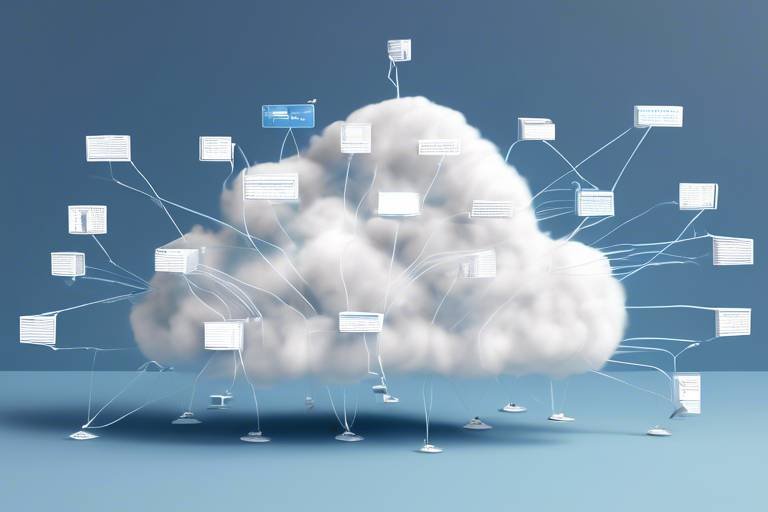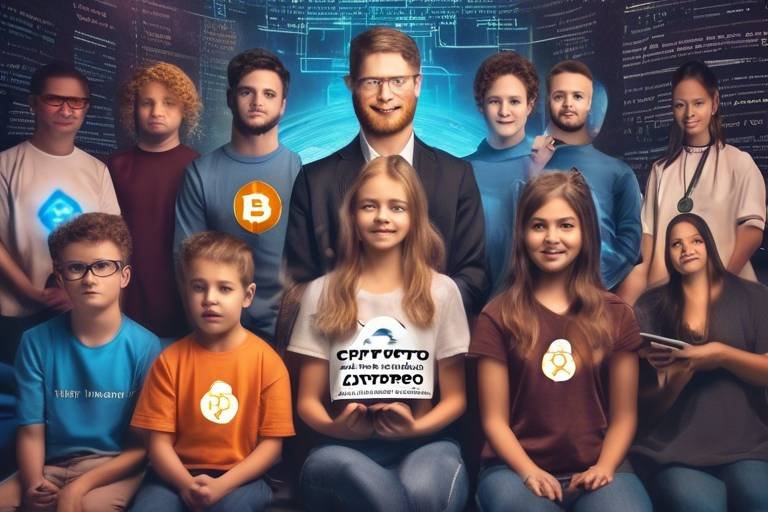How Blockchain is Revolutionizing Charity and Nonprofits
In a world where trust is often in short supply, especially in the realms of charity and nonprofit organizations, blockchain technology emerges as a beacon of hope. Imagine a system where every donation is tracked transparently, where every dollar spent is accounted for, and where donors can see the direct impact of their contributions. This is not just a dream—it's the reality that blockchain is creating. By leveraging the power of an immutable ledger, blockchain is not only enhancing transparency but also reshaping the way charities operate, making them more efficient and trustworthy. The implications are profound, as this technology holds the potential to fundamentally change the landscape of charitable giving.
One of the most significant advantages of blockchain is its ability to provide an immutable ledger. This means that once a transaction is recorded, it cannot be altered or deleted. For donors, this is a game-changer. Imagine being able to track your donation from the moment you click "donate" to the point where it reaches the intended beneficiary. With blockchain, this is entirely possible. Donors can see exactly how their contributions are being used, which increases their confidence in the organization they are supporting. This level of transparency fosters trust, which is essential in the nonprofit sector where every penny counts.
In addition to transparency, blockchain technology streamlines the fundraising process. Traditional methods often involve numerous intermediaries, each taking a cut of the donations. With blockchain, these middlemen can be eliminated, allowing nonprofits to allocate more resources directly to their causes. This means that for every dollar donated, a larger portion goes directly to the intended purpose. This increased efficiency not only maximizes the impact of each donation but also minimizes the administrative costs typically associated with fundraising efforts.
One of the most exciting applications of blockchain in the nonprofit sector is the use of smart contracts. These are self-executing contracts with the terms of the agreement directly written into code. In the context of fundraising, smart contracts can automate the donation process. For instance, funds can be released only when specific conditions are met, such as reaching a certain fundraising goal or completing a project milestone. This automation enhances accountability and reduces the risk of mismanagement, ensuring that funds are used as intended.
Regulatory compliance can be a daunting task for nonprofits, often consuming valuable time and resources. However, blockchain technology simplifies this process. By providing a clear record of transactions, organizations can easily demonstrate compliance with legal requirements. This allows nonprofits to focus more on their mission and less on paperwork, ultimately leading to a greater impact in the communities they serve.
Imagine being able to provide real-time updates on fundraising progress and fund allocation to your supporters. With blockchain, this is entirely feasible. Organizations can offer instant insights into how donations are being used, fostering greater engagement and trust among stakeholders. This level of communication not only keeps donors informed but also encourages them to become more involved in the organization's activities.
Another transformative aspect of blockchain is the rise of decentralized fundraising platforms. These platforms enable direct donations from supporters to causes, eliminating intermediaries and ensuring that more funds reach the intended beneficiaries. This direct connection between donors and recipients not only enhances trust but also empowers individuals to support causes they are passionate about without the fear of funds being mismanaged.
Blockchain technology also facilitates better communication and interaction between nonprofits and their supporters. By leveraging this technology, organizations can create personalized experiences that resonate with their donors. For example, blockchain allows for the tokenization of donations, where supporters receive tokens in exchange for their contributions. These tokens can represent various rewards or incentives, creating a sense of community among supporters and encouraging ongoing engagement.
Perhaps one of the most empowering aspects of blockchain is its ability to enable community-driven initiatives. This technology allows grassroots movements to thrive, giving communities the tools they need to take charge of fundraising efforts. By addressing local needs effectively, blockchain ensures that the voices of those directly affected by issues are heard and prioritized. This grassroots approach not only enhances the relevance of charitable efforts but also strengthens community bonds.
- What is blockchain technology? Blockchain is a decentralized digital ledger that records transactions across multiple computers, making it nearly impossible to alter or hack.
- How does blockchain enhance transparency in charities? It allows donors to track their contributions in real-time, ensuring that funds are used as intended.
- What are smart contracts? Smart contracts are self-executing contracts with the terms of the agreement directly written into code, automating processes and enhancing accountability.
- Can blockchain help reduce fundraising costs? Yes, by eliminating intermediaries, blockchain can significantly lower administrative costs, allowing more funds to go directly to the cause.

Transparency in Donations
In the world of charity, trust is everything. Donors want to know that their hard-earned money is being put to good use, and this is where blockchain technology steps in like a superhero ready to save the day. Imagine a world where every donation you make can be traced, where you can see exactly how your contribution is impacting lives in real-time. Sounds incredible, right? Well, with blockchain, this isn’t just a dream; it’s becoming a reality.
Blockchain operates on a decentralized, immutable ledger, which means once a transaction is recorded, it cannot be altered or deleted. This feature creates a level of transparency that traditional donation methods simply cannot offer. For instance, if you donate to a nonprofit organization, you can follow your funds through the blockchain, ensuring they reach the intended cause without any shady business lurking in the shadows. This transparency not only builds trust but also encourages more people to contribute, knowing their money is being used wisely.
Let’s break down how this transparency plays out:
- Real-time Tracking: Donors can see where their money goes, from the moment it leaves their wallet to when it’s used to make a difference.
- Accountability: Nonprofits are held to a higher standard, as they must be able to provide proof of how funds are allocated and spent.
- Increased Trust: When donors see that their contributions are making a tangible impact, they’re more likely to give again in the future.
Moreover, this level of transparency can also help organizations attract more funding. Imagine a nonprofit showcasing a detailed report of how every dollar is spent, complete with transaction records visible on the blockchain. This not only reassures existing donors but also catches the eye of potential new supporters who are looking for trustworthy organizations to invest in.
To illustrate this point further, let’s consider a hypothetical example. A charity focused on providing clean water in underdeveloped regions uses blockchain to track donations. Each donor can see how much money has been collected, how it’s being spent on various projects (like drilling wells or purchasing filtration systems), and even the impact of their contributions. This kind of transparency can lead to an exponential increase in donations, as people feel more connected to the cause and see the direct impact of their generosity.
In summary, blockchain is not just a tech buzzword; it’s a game-changer for the charity sector. By enhancing transparency in donations, it fosters a culture of accountability and trust. Donors can feel confident that their money is being used effectively, which ultimately leads to a healthier ecosystem for charitable giving. In an age where skepticism often reigns, blockchain offers a beacon of hope for both donors and nonprofits alike.

Improved Fundraising Efficiency
In the ever-evolving landscape of charity and nonprofit organizations, fundraising efficiency is a crucial factor that can determine the success of initiatives aimed at making a difference. Traditional fundraising methods often come with a slew of overhead costs that can eat into the funds meant for the cause. This is where blockchain technology steps in, acting as a game changer by streamlining processes and significantly reducing these costs. Imagine a world where every dollar you donate goes directly to the cause you care about, without being siphoned off by administrative fees or third-party intermediaries. Sounds appealing, right?
Blockchain achieves this by providing a transparent and decentralized platform for donations. By cutting out the middleman, nonprofits can allocate a larger portion of donations directly to their intended projects. For instance, if a donor contributes $100, instead of only $70 reaching the actual cause due to various fees, blockchain can ensure that the entire $100 is utilized effectively. This not only maximizes the impact of each donation but also enhances the overall trust in the organization.
Additionally, the efficiency brought by blockchain allows organizations to focus on what truly matters—their mission. With reduced administrative burdens, nonprofits can direct their energies toward innovative fundraising strategies and community engagement. This shift in focus is akin to a race car shedding unnecessary weight to achieve higher speeds. The result? A more agile and responsive organization capable of adapting to the needs of its beneficiaries.
Moreover, the introduction of smart contracts within the blockchain ecosystem further enhances fundraising efficiency. These contracts automate the donation process, ensuring that funds are released only when predetermined conditions are met. For example, if a nonprofit is raising funds for a specific project, a smart contract can be programmed to release funds only when certain milestones are achieved. This not only adds a layer of accountability but also minimizes the risk of mismanagement, ensuring that every dollar is spent wisely.
To illustrate the impact of blockchain on fundraising efficiency, consider the following table:
| Traditional Fundraising | Blockchain Fundraising |
|---|---|
| High overhead costs | Lower overhead costs |
| Delayed fund allocation | Real-time fund allocation |
| Limited donor engagement | Enhanced donor engagement |
| Opaque donation tracking | Transparent donation tracking |
In conclusion, the integration of blockchain technology into the fundraising processes of nonprofits is not just a trend; it is a significant evolution. By embracing this technology, organizations can enhance their operational efficiency, maximize the impact of donations, and build stronger relationships with their supporters. The future of fundraising is undoubtedly brighter with blockchain leading the charge, paving the way for a more transparent, efficient, and impactful charitable landscape.
- How does blockchain ensure transparency in donations?
Blockchain's immutable ledger allows donors to track their contributions in real-time, ensuring that funds are used as intended. - What are smart contracts?
Smart contracts are automated agreements that execute actions when specific conditions are met, enhancing accountability in the donation process. - Can blockchain reduce overhead costs for nonprofits?
Yes, by eliminating intermediaries and streamlining processes, blockchain can significantly lower administrative costs. - How can donors engage more with nonprofits using blockchain?
Blockchain facilitates better communication and interaction, allowing for personalized experiences and increased donor loyalty.

Smart Contracts in Fundraising
Imagine a world where every donation made to a charity is not just a leap of faith, but a well-structured agreement that guarantees accountability. This is where smart contracts come into play. These self-executing contracts with the terms of the agreement directly written into code are revolutionizing the way nonprofits manage donations. They automate the entire donation process, ensuring that funds are released only when specific conditions are met, thus enhancing accountability and significantly reducing the risk of mismanagement.
For instance, consider a nonprofit organization aiming to fund a clean water project. With a smart contract, the organization can set conditions such as "release funds only when the water purification system is installed and operational." This means that donors can rest assured that their contributions are being used for the intended purpose, as funds will only be transferred when the project milestones are achieved. It’s like having a safety net for your donations!
Moreover, smart contracts eliminate the need for intermediaries, which often slow down the donation process and add unnecessary costs. By automating transactions, nonprofits can redirect those savings back into their programs, maximizing the impact of each donation. In a nutshell, smart contracts not only streamline operations but also build trust between donors and organizations. When donors know their money is safeguarded by transparent conditions, they’re more likely to contribute.
To illustrate the effectiveness of smart contracts in fundraising, let’s look at a simple table comparing traditional fundraising methods with those utilizing smart contracts:
| Aspect | Traditional Fundraising | Smart Contracts |
|---|---|---|
| Transparency | Limited visibility on fund usage | Real-time tracking of funds |
| Accountability | Dependent on trust | Automated conditions ensure accountability |
| Cost Efficiency | Higher overhead due to intermediaries | Reduced costs, more funds to causes |
| Speed of Transactions | Can be slow due to manual processes | Instant execution of contracts |
In essence, smart contracts are not just a technological advancement; they are a paradigm shift in how we think about charity and donations. They empower both donors and nonprofits by fostering a culture of trust and transparency. As more organizations begin to adopt this technology, we can expect to see a significant transformation in the nonprofit sector, where every penny counts and every donation is a step towards meaningful change.
- What are smart contracts? Smart contracts are self-executing contracts with the terms directly written into code, allowing for automatic execution when conditions are met.
- How do smart contracts enhance accountability? They ensure that funds are only released when specific conditions are satisfied, reducing the risk of mismanagement.
- Can smart contracts reduce fundraising costs? Yes, by eliminating intermediaries and automating processes, smart contracts can significantly lower overhead costs.
- Are smart contracts secure? Yes, they are built on blockchain technology, which provides a high level of security and transparency.

Automated Compliance
In the world of charity and nonprofits, compliance with regulations is not just a legal requirement; it's a cornerstone of trust and credibility. With the advent of blockchain technology, the compliance landscape is undergoing a significant transformation. Imagine a scenario where organizations can automate their compliance processes, minimizing human error and enhancing transparency. This is where blockchain shines!
Blockchain provides a secure and transparent framework that simplifies the complex web of regulations nonprofits must navigate. By utilizing smart contracts, organizations can ensure that they meet regulatory requirements automatically. For example, a nonprofit can set specific conditions within a smart contract that must be fulfilled before funds are released. This not only ensures that the organization adheres to legal standards but also builds trust with donors who want to know their contributions are being managed responsibly.
Furthermore, the immutable nature of blockchain means that once a transaction is recorded, it cannot be altered or deleted. This feature is crucial for compliance, as it creates a permanent record of all financial activities. Nonprofits can easily generate reports that demonstrate adherence to regulations, making audits less daunting. Imagine being able to provide regulators with a comprehensive, real-time view of your financial dealings at the click of a button!
To illustrate the benefits of automated compliance through blockchain, consider the following table:
| Feature | Benefits |
|---|---|
| Smart Contracts | Automate compliance checks and fund releases based on predefined conditions. |
| Immutable Ledger | Provides a permanent record of transactions, enhancing trust and accountability. |
| Real-time Reporting | Facilitates easy generation of compliance reports, reducing administrative burden. |
Not only does blockchain streamline compliance, but it also allows nonprofits to focus more on their missions rather than getting bogged down by paperwork. By removing the complexities associated with regulatory adherence, organizations can allocate their resources more effectively, ensuring that funds are directed toward meaningful initiatives rather than administrative overhead.
In conclusion, the integration of blockchain technology into the compliance processes of nonprofits is a game-changer. It fosters a culture of transparency, accountability, and trust, which is essential in today’s philanthropic landscape. As more organizations embrace this technology, we can expect to see a shift towards a more efficient and trustworthy nonprofit sector.
- What is automated compliance? Automated compliance refers to the use of technology, like blockchain, to ensure that organizations adhere to legal and regulatory requirements without manual intervention.
- How does blockchain enhance transparency in nonprofits? Blockchain creates an immutable ledger of transactions that can be publicly verified, ensuring that funds are used as intended.
- Can smart contracts be customized for specific compliance needs? Yes! Smart contracts can be programmed to meet the specific regulatory requirements of different organizations.

Real-time Reporting
Imagine being able to see exactly where your donation is going, right down to the last cent. With blockchain technology, this is not just a dream but a reality. Real-time reporting allows nonprofits to offer immediate updates on fundraising progress and how funds are allocated. This transparency is a game-changer for both donors and organizations, fostering a deeper sense of trust and engagement.
In traditional charity models, donors often find themselves in the dark about how their contributions are utilized. They may receive annual reports or updates, but these can be vague and lack the granularity that today’s tech-savvy donors crave. Blockchain changes this by providing an immutable ledger where every transaction is recorded and can be viewed publicly. This means that donors can track their contributions in real-time, seeing exactly how their money is being used, whether it’s for purchasing supplies, funding a project, or supporting operational costs.
Moreover, real-time reporting can significantly enhance the relationship between nonprofits and their supporters. When organizations provide regular updates on their activities, it not only keeps donors informed but also makes them feel like they are part of the journey. Imagine getting a notification that your donation has just funded a new classroom in a remote village or that it has helped provide clean water to a community in need. This level of engagement can transform a one-time donor into a lifelong supporter.
To illustrate the benefits of real-time reporting, consider the following table:
| Feature | Traditional Reporting | Blockchain Real-time Reporting |
|---|---|---|
| Transparency | Limited and often delayed | Immediate and verifiable |
| Donor Engagement | Occasional updates | Continuous interaction and updates |
| Trust | Variable | High due to transparency |
| Accountability | Dependent on organization | Built-in through technology |
In conclusion, real-time reporting powered by blockchain technology not only enhances transparency but also builds trust and engagement between charities and their supporters. By allowing donors to see the impact of their contributions as they happen, blockchain is paving the way for a new era of charitable giving where accountability is paramount and every contribution counts.
- What is blockchain technology? Blockchain is a decentralized digital ledger that records transactions across many computers, ensuring that the data cannot be altered retroactively.
- How does real-time reporting work? Real-time reporting uses blockchain to provide immediate updates on donations and fund usage, allowing donors to track their contributions transparently.
- Can I see how my donation is being used? Yes! With blockchain, you can track your donation in real-time and see exactly how it is being allocated by the nonprofit.
- Why is transparency important in charity? Transparency builds trust between donors and organizations, ensuring that funds are used effectively and as intended.

Decentralized Fundraising Platforms
Imagine a world where your donations go directly to the causes you care about, without any middlemen siphoning off funds. make this dream a reality by leveraging blockchain technology to create a more transparent and efficient donation process. These platforms allow supporters to connect directly with nonprofits, ensuring that every penny of your contribution is utilized effectively. In this new paradigm, the power shifts from large organizations to the grassroots level, fostering a sense of community and shared responsibility.
One of the most significant advantages of decentralized fundraising is the elimination of intermediaries. Traditional fundraising models often involve banks, payment processors, and other entities that can take a cut of the donations. With blockchain, transactions are peer-to-peer, meaning that funds can be sent directly from donors to the intended recipients. This not only reduces costs but also enhances the speed of transactions. Donors can see their contributions in real-time, fostering a sense of trust and urgency.
Furthermore, decentralized platforms often incorporate smart contracts, which automatically execute transactions based on predefined conditions. For example, if a nonprofit reaches a specific fundraising goal, the smart contract can automatically release the funds. This level of automation reduces the risk of mismanagement and ensures that the funds are allocated as intended. As a result, donors can feel confident that their money is being used effectively, which is crucial for building long-term relationships between nonprofits and their supporters.
Moreover, decentralized fundraising platforms encourage community-driven initiatives. These platforms empower individuals to create and promote their fundraising campaigns, allowing local needs to be addressed effectively. For instance, a community facing a natural disaster can quickly organize a fundraising campaign, reaching out to supporters directly through these platforms. This grassroots approach not only increases engagement but also helps to foster a sense of ownership among community members.
To summarize, decentralized fundraising platforms are revolutionizing the way nonprofits operate by:
- Eliminating intermediaries, ensuring that more funds reach the intended beneficiaries.
- Utilizing smart contracts for enhanced accountability and efficiency.
- Empowering communities to take charge of their fundraising efforts.
As we move forward, the potential for decentralized platforms to transform the charity landscape is immense. By embracing these innovative tools, nonprofits can enhance their operations, engage more effectively with donors, and ultimately make a more significant impact on the causes they serve.
What are decentralized fundraising platforms?
Decentralized fundraising platforms are blockchain-based systems that allow donors to contribute directly to causes without intermediaries, ensuring greater transparency and efficiency in the donation process.
How do smart contracts work in fundraising?
Smart contracts are self-executing contracts with the terms of the agreement directly written into code. In fundraising, they can automate the release of funds based on specific conditions being met, ensuring accountability.
Can anyone create a fundraising campaign on these platforms?
Yes! Decentralized fundraising platforms typically allow anyone to create and promote their campaigns, empowering individuals and communities to address their unique needs.
What benefits do donors receive from using decentralized platforms?
Donors benefit from increased transparency, lower transaction fees, and the assurance that their contributions are going directly to the intended causes.

Enhanced Donor Engagement
In the ever-evolving world of philanthropy, donor engagement has become a crucial element for the success of nonprofit organizations. With the advent of blockchain technology, charities are now equipped with tools that not only enhance engagement but also foster a deeper connection between donors and the causes they care about. Imagine being able to see exactly how your contribution is making a difference—this is the reality that blockchain brings to the table.
One of the most significant advantages of blockchain is its ability to create a transparent and interactive environment for donors. For instance, donors can track their contributions in real-time, seeing how their funds are allocated and utilized. This level of transparency is akin to having a backstage pass to your favorite concert; you get to witness how everything comes together, which in turn, enhances your appreciation for the experience. When donors feel informed and involved, their loyalty to the organization strengthens, leading to long-term support.
Moreover, blockchain facilitates better communication between nonprofits and their supporters. Through decentralized platforms, organizations can send personalized updates about ongoing projects directly to donors. This not only keeps the donors in the loop but also allows them to share their experiences and feedback, creating a two-way dialogue that enriches the relationship. Imagine receiving a message saying, “Thanks to your generous contribution, we were able to provide clean water to 500 families this month!” Such direct communication can be incredibly motivating and fulfilling for donors.
Another innovative aspect of blockchain is the tokenization of donations. By introducing tokens as a form of contribution, organizations can incentivize giving in a unique way. Donors might receive tokens in return for their contributions, which can be used for various benefits, such as exclusive updates, merchandise, or even voting rights on future projects. This not only creates a sense of community among supporters but also turns giving into a more engaging and rewarding experience. It’s like being part of a club where every member’s voice matters, and contributions are celebrated.
Furthermore, blockchain empowers communities to take charge of their fundraising efforts. Grassroots initiatives can thrive with the help of decentralized platforms, allowing local needs to be addressed more effectively. Imagine a community project where residents can directly fund initiatives that matter to them, without the interference of intermediaries. This level of control fosters a sense of ownership and responsibility among community members, enhancing overall engagement and participation.
In conclusion, the integration of blockchain technology into the nonprofit sector is not just a passing trend; it’s a game-changer that enhances donor engagement in remarkable ways. By promoting transparency, facilitating communication, and creating community-driven initiatives, blockchain is paving the way for a more connected and engaged philanthropic landscape. As we continue to explore these innovations, one thing is clear: the future of charity will be built on trust, transparency, and an unwavering commitment to making a difference.
- How does blockchain improve donor engagement? Blockchain improves donor engagement by providing transparency in fund allocation, facilitating direct communication, and enabling tokenization of donations.
- What are tokens in the context of donations? Tokens are digital assets that can be given to donors as a form of incentive, allowing them to access exclusive benefits or participate in decision-making processes.
- Can blockchain help grassroots initiatives? Yes, blockchain empowers grassroots initiatives by enabling direct fundraising and allowing communities to prioritize their local needs without intermediaries.
- Is donor tracking secure with blockchain? Absolutely! Blockchain provides an immutable and secure ledger, ensuring that donor contributions are tracked reliably and transparently.

Tokenization of Donations
Imagine a world where every dollar you donate not only helps a cause but also gives you a stake in its success. This is the magic of tokenization in the realm of charitable giving. Tokenization refers to the process of converting an asset or a right into a digital token on a blockchain. In the context of donations, this means that when you contribute to a nonprofit, you receive a token that represents your donation. This token can be used in various ways, creating a dynamic ecosystem that enhances both donor engagement and organizational accountability.
One of the most exciting aspects of tokenization is that it allows organizations to create a sense of community among supporters. When donors receive tokens, they are not just giving away money; they are becoming part of a collective effort. These tokens can serve multiple purposes:
- Incentives for Contributions: Nonprofits can offer rewards or benefits tied to the number of tokens a donor holds. For instance, reaching a certain threshold of tokens might grant access to exclusive events or updates from the organization.
- Voting Rights: Token holders may have the ability to vote on specific initiatives or projects, giving them a voice in how their contributions are utilized. This democratic approach fosters deeper connections between the organization and its supporters.
- Transferability: Tokens can often be transferred or traded, allowing supporters to share their commitment with friends or family. This feature can help raise awareness and encourage others to contribute.
Furthermore, tokenization enhances transparency in the donation process. Each token transaction is recorded on the blockchain, providing a clear and immutable record of how funds are being used. Donors can easily track their contributions and see the impact of their generosity, which builds trust and encourages ongoing support.
To illustrate the potential of tokenization, consider the following table that outlines the benefits of tokenized donations compared to traditional donation methods:
| Aspect | Traditional Donations | Tokenized Donations |
|---|---|---|
| Transparency | Limited tracking | Full visibility on blockchain |
| Engagement | One-time interaction | Ongoing community involvement |
| Incentives | None | Rewards and benefits |
| Accountability | Hard to verify | Immutable records |
In conclusion, the tokenization of donations is not just a trend; it is a revolutionary shift in how we think about charitable giving. By transforming the way donations are perceived and managed, blockchain technology is paving the way for a more engaged, transparent, and community-driven approach to philanthropy. So, the next time you consider making a donation, think about how tokenization might enhance your experience and impact.
Q: What is tokenization in the context of donations?
A: Tokenization involves converting a donation into a digital token on a blockchain, which can represent various rights or benefits for the donor.
Q: How does tokenization increase donor engagement?
A: By providing tokens that can be used for rewards, voting, or trading, donors feel more connected to the cause and are incentivized to continue their support.
Q: Is the process of tokenization secure?
A: Yes, tokenization is built on blockchain technology, which provides a secure and transparent way to track transactions and donations.
Q: Can I track my donations if they are tokenized?
A: Absolutely! Each token transaction is recorded on the blockchain, allowing you to see exactly how your contributions are being used.

Community-driven Initiatives
In the ever-evolving landscape of charitable giving, are emerging as a powerful force, thanks in large part to blockchain technology. Imagine a world where local communities can directly fund their own projects, bypassing the traditional bottlenecks of large organizations and bureaucracies. This is not just a dream; it’s a reality made possible by the transparency and efficiency of blockchain. With the ability to create decentralized fundraising platforms, communities can rally together to support causes that matter most to them, ensuring that every dollar raised goes directly to the intended purpose.
One of the most exciting aspects of this shift is how it empowers individuals to take charge of their own initiatives. For instance, a small neighborhood could band together to fund a community garden or a local sports team. Instead of relying on distant charities that may not fully understand their needs, they can leverage blockchain to create a transparent funding mechanism. This not only fosters a sense of ownership but also cultivates a deeper connection between donors and the causes they support. When people see their contributions making a tangible difference in their own backyard, it ignites a passion for giving that is hard to replicate.
Moreover, blockchain allows for the creation of tokenized donations, where supporters receive digital tokens in return for their contributions. These tokens can serve multiple purposes: they can be used as a form of currency within the community, granting access to special events, or even providing voting rights on future projects. This gamification of giving makes the act of donating not just a charitable act, but an engaging experience that encourages ongoing participation. Imagine attending a local festival where your tokens can be exchanged for food, activities, or even a say in what the community should focus on next!
As communities harness the power of blockchain, they also gain the ability to track the impact of their initiatives in real-time. With every transaction recorded on an immutable ledger, community members can see exactly how funds are being utilized. This level of transparency builds trust and encourages more people to get involved. When individuals can witness the direct results of their contributions—be it a newly built playground or a successful local art project—they are more likely to spread the word and inspire others to join in.
In conclusion, the rise of community-driven initiatives facilitated by blockchain technology is a game-changer for the nonprofit sector. It not only democratizes the process of charitable giving but also fosters a sense of unity and purpose among community members. As we continue to explore the potential of blockchain, it becomes clear that the future of philanthropy lies in the hands of the very people it aims to help.
- What are community-driven initiatives?
Community-driven initiatives are local efforts to fund and support projects that address specific needs within a community, often facilitated by blockchain technology. - How does blockchain enhance community-driven initiatives?
Blockchain provides transparency, accountability, and direct funding mechanisms, allowing communities to manage their own projects effectively. - What is tokenization in the context of donations?
Tokenization refers to creating digital tokens that can represent contributions, incentivizing donations and fostering engagement within the community. - Can anyone participate in community-driven initiatives?
Yes, blockchain enables anyone within the community to contribute, participate, and influence local projects.
Frequently Asked Questions
- What is blockchain and how does it benefit charities?
Blockchain is a decentralized digital ledger that records transactions across many computers. For charities, it enhances transparency and trust by allowing donors to track their contributions, ensuring that funds are used as intended. This technology provides an immutable record that can significantly reduce fraud and mismanagement.
- How does blockchain improve fundraising efficiency?
By streamlining processes and cutting down on overhead costs, blockchain technology allows nonprofits to allocate more resources directly to their causes. This means that each donation can have a greater impact, maximizing the effectiveness of the funds raised.
- What are smart contracts and how do they work in fundraising?
Smart contracts are self-executing contracts with the terms of the agreement directly written into code. In fundraising, they automate the donation process, ensuring that funds are only released when specific conditions are met. This increases accountability and minimizes the risk of mismanagement.
- How does blockchain simplify compliance for nonprofits?
Blockchain technology can automate many aspects of regulatory compliance, allowing nonprofits to focus on their mission rather than getting bogged down in paperwork. This ensures that they adhere to legal requirements while spending more time on their charitable activities.
- Can blockchain provide real-time updates on fundraising progress?
Absolutely! With blockchain, organizations can offer real-time reporting on fundraising efforts and how funds are allocated. This fosters greater engagement and trust among stakeholders, as everyone can see exactly where their contributions are going.
- What are decentralized fundraising platforms?
Decentralized fundraising platforms allow donors to contribute directly to causes without intermediaries. This means that more funds reach the intended beneficiaries, helping to eliminate inefficiencies and ensuring that donations are used effectively.
- How does blockchain enhance donor engagement?
Blockchain facilitates better communication between nonprofits and their supporters. It allows for personalized experiences, which can lead to increased donor loyalty. By providing transparency and direct interaction, donors feel more connected to the causes they support.
- What is tokenization of donations?
Tokenization involves creating digital tokens that represent donations. This process can incentivize contributions by offering rewards or creating a sense of community among supporters. It adds a gamified element to giving, making it more engaging.
- How does blockchain empower community-driven initiatives?
Blockchain enables communities to take charge of their fundraising efforts by providing the tools needed to manage resources effectively. This empowerment allows grassroots movements to thrive, ensuring that local needs are addressed in a timely and efficient manner.



















